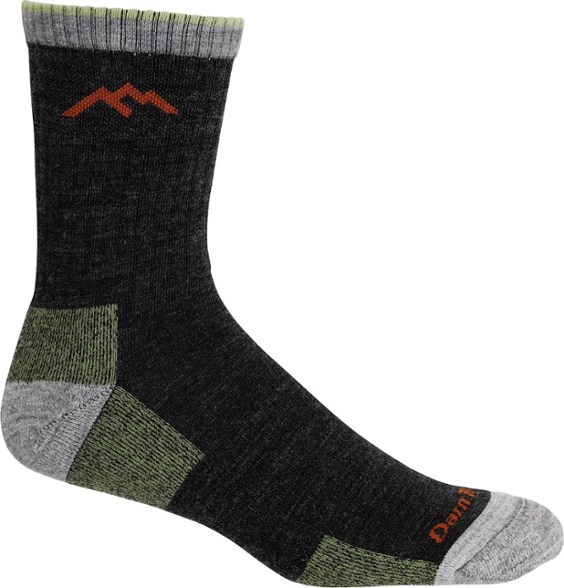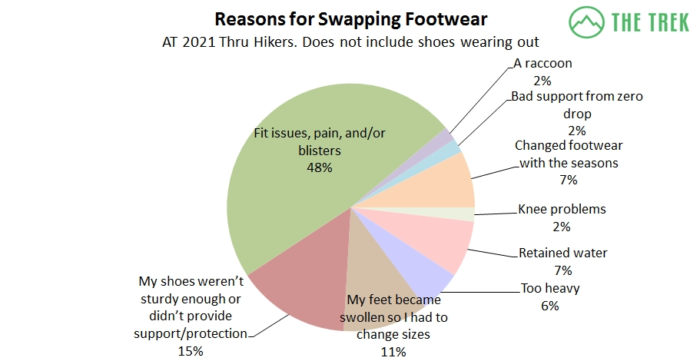The Top Footwear on the Appalachian Trail: 2021 Thru-Hiker Survey
Following the general information survey results released a few weeks ago, our attention now turns to Joal’s favorite subject: gear. Each year as part of The Trek’s annual thru-hiker survey, we ask hikers about the footwear used on the trail. Hiker surveys were hugely helpful to us ahead of our 2018 thru-hike, as we were coming from “across the pond” where 99% of hikers use a hiking boot. The surveys taught us about the footwear being used on Triple Crown trails and got us practicing with some of the popular trail runners mentioned in the survey. We still get funny looks hiking in trail runners in the UK, but are now fully converted.
The overall trends this year remained fairly consistent, although there are a few new brands and models that make an appearance.
Read the 2022 Top Footwear from the Appalachian Trail.
The Hiker Sample
310 hikers participated in the survey, all of whom had walked a section or thru-hike of the AT in 2021. Almost three-quarters were thru-hikers and the rest were section hikers. For more details on the hiker demographics, check out our detailed post with general information from the survey.
Footwear Types
More hikers than ever in our surveys (77%) started out wearing trail runners, while 16% started wearing hiking boots. 7% started in hiking shoes (low topped) with one person hiking in sandals. By the end of the trail, 89% of those who successfully completed a thru-hike were wearing trail runners, 7% were in hiking shoes and just 4% were still wearing hiking boots.
Over the years, we’ve seen a trend toward more and more hikers opting for trail runners instead of hiking boots. Mid-support, mid-flexibility hiking shoes that are somewhere between boots and trail runners are becoming increasingly common.
On request of Mo in the comments below, we’ve crunched the numbers on how shoe preference changed by age. As can be seen from the chart above, for hikers 48 and above the dominance of trail runners is less pronounced, but is still a clear favorite.
Satisfaction
Similar to what we have seen in previous surveys, hikers who began with sturdier, heavier footwear were significantly less satisfied than those who began with more lightweight footwear. Those who stuck to boots and completed a hike also reported mixed results on their footwear choice, with over 53% reporting negative sentiment to their footwear choice.
Those who wore hiking boots and were aiming to complete a thru-hike also had a lower success rate, with only 60% completing the trail, compared to the 81% success rate of those who wore trail runners. Overall, it’s clear that most thru-hikers will be the most satisfied with trail runners over more traditional hiking boots.

Changes in Footwear Type
We asked hikers why they changed their footwear. Not including shoes wearing out, about half said they did so due to fit issues, pain, or blisters and about 10% of hikers had to size up as their feet had increased in size. Interestingly, 15% felt the shoes they started with did not provide enough protection and swapped to a more sturdy pair. There were a number of other reasons listed on the chart, including a raccoon theft!
Replacements
We asked thru-hikers how many pairs of shoes they used throughout their trip. 76% used 4-5 pairs, which is in keeping with the conventional advice to swap out your shoes every 300-400 miles (this is when the cushion tends to disappear from the midsole). Three hikers used just one pair of trail runners, three used just two pairs, while 31 used three. The majority of those in hiking boots used just three pairs, lower than the average hiker in trail runners.
Top Footwear on the Appalachian Trail: Brands and Models
We asked hikers for their favorite brands and series/models of footwear and socks worn on the thru-hike. The most popular footwear was, as per previous years, Altra Lone Peak. This was worn by over a quarter of those who completed a thru-hike. The number of respondents wearing Hokas increased by 77% over the 2019 survey (going from 35 to 62 users). Meanwhile, the number of respondents wearing Salomons and Brooks fell by 53% (60 reported users in 2019 vs. 28 this year) and 44% (25 users in 2019 vs. 14 this year), respectively.
For socks, there was again a clear winner with three-quarters of those surveyed using Darn Tough socks. Notes on the data below: a lot of hikers did not supply a model, just a make.
- Top overall model: Altra Lone Peak (72), Versions 4.5 and 5 were most popular
- Top sock brand: Darn Tough (225)
1) Altra (127 hikers’ favorite)
-
Lone Peak series (72)
-
Nearly all hikers wore Lone Peaks 4.5 or 5.
-
-
Olympus (44)
-
this was a tenfold increase from last year.
-
-
Timp (8)
2) HOKA ONE ONE (62)
-
Speedgoat (53)
-
Stinson (5)
-
Challenger (1)
3) Salomon (28)
-
XA Pro 3D (10)
-
Speedcross (5)
-
X Ultra, some GTX, some not (5)
4) Merrell (15)
-
Moab (14)
5) Brooks (14)
5) Oboz (10)
-
Sawtooth (4)
7) La Sportiva (6)
8) North Face (5)
Socks

By far the most popular brand of socks worn by long-distance hikers was Darn Tough, worn by two-thirds (73%) of hikers. Darn Tough provides a lifetime warranty, meaning they will replace any pair if you mail them the old washed pair.
-
Darn Tough (225)
-
Injinji (32)
-
Smartwool (20)
-
Farm to Feet (8)
Very few people remembered sock models, and there are so many of them, that this information was not possible to report.
Summary
Each year, a higher percentage of hikers have opted to wear trail runners for the majority of the hike, rather than heavier, sturdier boots or shoes. While boots may still be preferable during the snowy sections, we recommend that hikers planning thrus or long sections should consider lightweight, more flexible shoes for the majority of their hikes. In general, thru-hikers should plan to go through 4-5 pairs of shoes.
Altra has maintained its lead from last year as the most popular brand for trail runners. The Altra Lone Peak was the most popular trail runner and the most popular footwear on the AT overall with 25% of users using this model. Darn Tough, Injinji, and Smartwool socks were all well represented on the AT, but Darn Tough were by far the most popular socks with 75% of respondents using them.
Conclusion
Many thanks to the hikers who participated in the survey! Congratulations to you all! Check out our previous post with general hiker information. Upcoming posts from this year’s survey will cover tents and hammocks, backpacks, sleeping bags and pads, and stoves/food/water. To stay updated on the subsequent hiker survey posts, subscribe to The Trek newsletter.
Data Caveat
Data was collected from participants recruited via our social media platforms, Backpacker Radio, and TheTrek.co. Participants submitted surveys anonymously between October and November of 2021. There was some data cleanup done during the analysis of the data where obvious spelling mistakes were made e.g. we had 10 different spellings of Injinji. We also changed any start dates that referenced 2022 to 2021 and couldn’t find any obvious duplicates in the data. That said, please keep in mind you can’t always believe the answers to what you ask strangers on the internet.
Featured image: Graphic design by Chris Helm (@chris.helm).
This website contains affiliate links, which means The Trek may receive a percentage of any product or service you purchase using the links in the articles or advertisements. The buyer pays the same price as they would otherwise, and your purchase helps to support The Trek's ongoing goal to serve you quality backpacking advice and information. Thanks for your support!
To learn more, please visit the About This Site page.
















Comments 24
Thanks for the review! I am 71 at present (72 next June 8th) and I am prepping physically (am in good shape for my age with no handicaps)
for my AP trip and the socks and shoes are those I am going to buy today and wear them on the ship I am on to see how they feel.
Thanks Clifford. We’re glad this was helpful.
If only there were Trail Walkers that came in size 12 4E.
Thank you for that great article. I’m curious how the breakdown was by age. Was there a correlation between age and type of shoe worn? I’m in the process of getting back into backpacking after a 20 year hiatus. As an older hiker (60) I lean toward boots because 1) That’s all I’ve ever backpacked in and, 2) I feel I need the added ankle support. Altra Lone Peak Hightops weigh approximately 22oz less than the Lowa Renegade GTX Mid. That’s a pretty big savings and the Altra’s hightops give added ankle support. Maybe it’s time I get with the times. Regardless, I’m interested to see if the majority of boot wearers are in my age range. Thank you.
Ask and you shall receive! I’ve included the chart in the article for you now (under the footwear types section).
Thank you for adding that graphic. I really thought the boot usage for older hikers would be higher. That said, I’m strongly considering switching from boots (I love my Lowa Renegades) to Trail Runners. Thank you for all of the work you put into the article.
thanks for the article I don’t know how a came across it but I am a shuttle driver for the application trail for massachusetts southern half of Vermont
What kind of hiking boots did they hikers use?
Hi Rammy,
The hiking boots are listed above but the main ones were the Columbia Bridgers, the Merrel Moab, The Oboz Sawtooth and the Solomon X Ultra GTX.
Hope this helps
Joal
I’d be curious to know what shoes hikers we’re wearing . Who went through three pairs or less?
Hi Noda,
The following models were the ones used by hikers who used three or less: Cascadia, Lone Peak, Olympus, Sawtooth, Speedgoat, X Ultra GTX
Thanks
Joal
About the shoes: wouldn’t it be interesting to see this on a brand level? Because 48%, a significant number changes it’s footwear due to fit reasons.
Look at the two charts: ‘Satisfaction’ and ‘Changes in Footwear Type’
For example: the Lone Peak can be the most popular (read: people that started with it) but could have a potential higher drop rate then another. Or any other brand/type for the matter. If the Speedgoat are up for 77%, this could be from Lone Peak users that switch?
Trying to figure out what marketing is playing here…
I would like to know how the favorite and most popular backpacks ,tents,and sleeping bags and other gear hold-up like how durable they were. And in the condition they were in at the end of trip
Hi guys! This is Rob from Outdoor 76. If you guys are interested, we’d love to be a part of you future footwear related posts. We saw est 4,000 nobo’s this year and feet are far and away our #1 specialty. I think we have some pretty relevant contributions we could offer.
“Those who wore hiking boots and were aiming to complete a thru-hike also had a lower success rate, with only 60% completing the trail, compared to the 81% success rate of those who wore trail runners.”
This statement is extremely problematic. I think it might reasonably lead readers to draw the conclusion that their chances of succeeding on a thru-hike will be increased if they wear trail runners rather than boots, when it is entirely possible that the reverse is true. We just don’t know without a deeper analysis of the data that isolates the effect of footwear on completion rates from other factors like age of hiker.
I still hike in my old Thom McAn all leather alpine boots (2 lbs 6 oz each) that I bought when I was in Boy Scouts back in ’75. Looking into upgrading to the Danner Mountain Light II for this season which are just under 2 pounds each. And I just put the $100 deposit down to get on the three year wait list for a pair of Limmers. Old school, baby, old school!
Historically, boots vs. shoes have been largely a function of weight; i.e. hiker + gear. Sturdy boots were a necessity when we carried 40lb+ backpacks on extended hikes. The current trend has been towards lighter thru-hiking gear, thus the trend towards lighter (and thus “less” sturdy) hiking boots and trail running shoes, while still providing the traction necessary for hiking wet but well-beaten trails like the AT. Personally I hiked the rockiest part of the AT thru Rocksylvania in light hiking shoes and I found it to be a profoundly miserable experience. Also look at the number of pairs of these lightweight shoes that hikers are going thru. That’s got to contribute significantly to the estimates I’ve read from “experienced” hikers that it could cost upwards of $1000/month to thruhike the AT. Practically speaking, wouldn’t it be better to choose a sturdy medium hiking shoe or boot and maybe only go thru 2 pairs at most, or have one good pair resoled? Also wouldn’t it be better for the environment to choose one really good pair of leather boots, that when totally worn out, will decay in a landfill, vs. half a dozen trail running shoes composed mostly of some man-made material that will take centuries to decay? I’d like to hear how all the REAL tree-huggers feel about this issue.